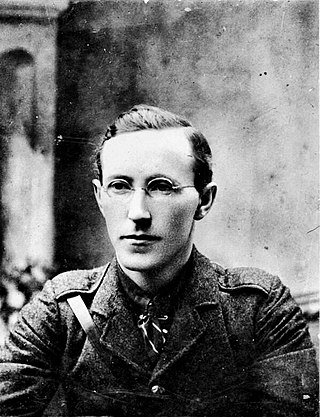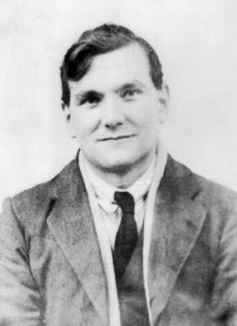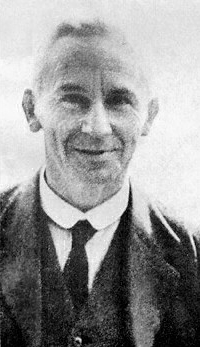
The Irish Civil War was a conflict that followed the Irish War of Independence and accompanied the establishment of the Irish Free State, an entity independent from the United Kingdom but within the British Empire.
Events from the year 1923 in Ireland.

Thomas Bernardine Barry, better known as Tom Barry, was a prominent guerrilla leader in the Irish Republican Army (IRA) during the Irish War of Independence and the Irish Civil War. He is best remembered for orchestrating the Kilmichael ambush, in which he and his column wiped out a 18-man patrol of Auxiliaries, killing sixteen men.

William Fanaghan Lynch was an officer in the Irish Republican Army during the Irish War of Independence of 1919–1921. During much of the Irish Civil War, he was chief of staff of the Irish Republican Army. On 10 April 1923, Lynch was killed whilst trying to escape an encirclement by Free State troops in south Tipperary.

Maurice Twomey was an Irish republican and the longest serving chief of staff of the Irish Republican Army (IRA).

The Irish Republican Army (IRA) is a name used by various paramilitary organisations in Ireland throughout the 20th and 21st centuries. Organisations by this name have been dedicated to anti-imperialism through Irish republicanism, the belief that all of Ireland should be an independent republic free from British rule.

The Irish Republican Army of 1922–1969, an anti-Treaty sub-group of the original Irish Republican Army (1919–1922), fought against the Irish Free State in the Irish Civil War, and its successors up to 1969, when the IRA split again into the Provisional IRA and Official IRA. The original Irish Republican Army fought a guerrilla war against British rule in Ireland in the Irish War of Independence between 1919 and 1921. Following the signing of the Anglo-Irish Treaty on 6 December 1921, the IRA in the 26 counties that were to become the Irish Free State split between supporters and opponents of the Treaty. The anti-Treatyites, sometimes referred to by Free State forces as "Irregulars", continued to use the name "Irish Republican Army" (IRA) or in Irish Óglaigh na hÉireann, as did the organisation in Northern Ireland which originally supported the pro-Treaty side. Óglaigh na hÉireann was also adopted as the name of the pro-Treaty National Army, and remains the official legal title of the Irish Defence Forces.
The Munster Republic was an informal and colloquial term used by Irish republicans to refer to the territory they held in the province of Munster at the start of the Irish Civil War. The "republic" never claimed to be a state as such, but was a base for the republican civil war aim of creating an all-Ireland Irish Republic.

Roderick O'Connor was an Irish republican revolutionary. He was Director of Engineering for the IRA in the Irish War of Independence. O'Connor opposed the Anglo-Irish Treaty of 1921 and was chairman of the republican military council that became the Anti-Treaty IRA in March 1922. He was the main spokesman for the republican side in the lead-up to the outbreak of the Irish Civil War in June of that year. On 30 June, O'Connor was taken prisoner at the conclusion of the attack by Free State forces on the Four Courts in Dublin. On 8 December 1922, he was executed along with three other senior members of the IRA Four Courts garrison. All four men were executed without trial or courts martial.
Liam Deasy was an Irish Republican Army officer who fought in the Irish War of Independence and the Irish Civil War. In the latter conflict, he was second-in-command of the Anti-Treaty forces for a period in late 1922 and early 1923.
The Irish Republican Army was a guerrilla army that fought the Irish War of Independence against Britain from 1919–1921. It saw itself as the legitimate army of the Irish Republic declared in 1919. The Anglo-Irish Treaty, which ended this conflict, was a compromise which abolished the Irish Republic, but created the self-governing Irish Free State, within the British Empire. The IRA was deeply split over whether to accept the Treaty. Some accepted, whereas some rejected not only the Treaty but also the civilian authorities who had accepted it. This attitude eventually led to the outbreak of the Irish Civil War in late June 1922 between pro- and anti-Treaty factions.
The Irish Free State offensive of July–September 1922 was the decisive military stroke of the Irish Civil War. It was carried out by the National Army of the newly created Irish Free State against anti-treaty strongholds in the south and southwest of Ireland.

The executions during the Irish Civil War took place during the guerrilla phase of the Irish Civil War. This phase of the war was bitter, and both sides, the government forces of the Irish Free State and the anti-Treaty Irish Republican Army (IRA) insurgents, used executions and terror in what developed into a cycle of atrocities. From November 1922, the Free State government embarked on a policy of executing Republican prisoners in order to bring the war to an end. Many of those killed had previously been allies, and in some cases close friends, of those who ordered their deaths in the civil war. In addition, government troops summarily executed prisoners in the field on several occasions. The executions of prisoners left a lasting legacy of bitterness in Irish politics.
This is a timeline of the Irish Civil War, which took place between June 1922 and May 1923. It followed the Irish War of Independence (1919–1921), and accompanied the establishment of the Irish Free State as an entity independent from the United Kingdom of Great Britain and Ireland.

Joseph McKelvey was an Irish Republican Army officer who was executed during the Irish Civil War without trial or courts martial. He participated in the Anti-Treaty IRA's repudiation of the authority of the Dáil Éireann, the civil government of the Irish Republic declared in 1919 in March 1922, and was elected to the IRA Army Executive. In April 1922, he helped command the occupation of the Four Courts in defiance of the new Irish Free State. This action helped to spark the civil war, between pro- and anti-treaty factions. McKelvey was among the most hardline of the republican side and, briefly in June 1922, became IRA Chief of Staff.
Liam Pilkington, also known as William Pilkington and Billy Pilkington, was a member of the IRA during the Irish War of Independence. Pilkington was General Officer Commanding (GOC) of the 3rd Western Division, IRA, from 1921 to 1923. After the conclusion of the Irish War of Independence Pilkington joined the Anti-Treaty IRA during the Irish Civil War. He attempted to become a politician for a short while, but was ultimately unsuccessful. Disillusioned due to the Irish Civil War, Pilkington became a Catholic priest for the remainder of his life. He served as a priest in South Africa and Wales before retiring to Liverpool, England, where he died.

Seán O'Hegarty was a prominent member of the Irish Republican Army in County Cork during the Irish War of Independence. He served as O/C of the Cork No. 1 Brigade of the IRA after the deaths of Tomás Mac Curtain and Terence MacSwiney.

Richard Barrett, commonly called Dick Barrett, was a prominent Irish Republican Army officer who fought in the War of Independence and on the Anti-Treaty side in the Irish Civil War. He was assistant quartermaster-general of the IRA with the rank of commandant. During the Civil War he was captured by Free State forces at the Four Courts on 30 June 1922 and later executed unlawfully on 8 December 1922.

John T. Prout was an Irish soldier. He served in the United States Army in the First World War, as a training officer in the guerrilla Irish Republican Army during the Irish War of Independence (1919–1921) and held one of the senior commands in the National Army during the Irish Civil War (1922–23).
The guerrilla phase of the Irish Civil War began in August 1922, when the forces of the Irish Free State took all the fixed positions previously held by the Anti-Treaty IRA. The IRA then waged a guerrilla war to try to bring down the new Irish Government and overturn the Anglo-Irish Treaty. This guerrilla campaign was ultimately defeated.














